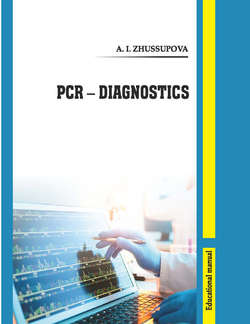Читать книгу PCR – diagnostics - Aizhan Zhussupova - Страница 9
Chapter 4
REAL-TIME PCR AND ITS THERMAL CYCLER SYSTEMS
ОглавлениеReal-time PCR (or qPCR), first introduced by Higuchi and coworkers in 1992 is a laboratory technique of molecular biology, used to amplify and simultaneously detect or quantify a targeted DNA molecule. Analysis of the progress of the reaction allows accurate quantification of the target sequence over a very wide dynamic range, provided suitable standards are available. Further study of its products within the original reaction mixture using probes and melting analysis can detect sequence variants including single base mutations. Since the first practical demonstration of the concept realtime PCR has found applications in many branches of biological science. Applications include gene expression analysis, the diagnosis of infectious disease and human genetic testing. With the correct kits, reagents and experimental design it is an exceptionally powerful research tool quick and easy to generate high quality meaningful data in no time; flexible, as many alternative instruments and fluorescent probe systems have been developed and are currently available; its assays can be completed rapidly since no manipulations are required for post-amplification.
Identification of the amplification products by probe detection in real-time is highly accurate compared with size analysis on gels. The probe is labeled at the 5’-end with the fluorescence donor (e.g. Fluorescein), a few bases downstream or on the 3’-end with a quencher (e.g. TAMRA). With no complementary sequence available the fluorescence of the donor is quenched (see Fig. 4.1).
Figure 4.1. Basic principles of real-time PCR
Real-time PCR thermocycler follows a protocol that alternates through temperatures that are optimal for denaturing, annealing, and extension (see Fig. 4.2).
Figure 4.2. Three steps of one real-time PCR cycle
Figure 4.3. Steps and variables of a successful mRNA quantification using real-time RT-PCR; From: http://www.gene-quantification.de/optimization.html
During PCR the labeled oligonucleotide hybridizes to the target sequence and the 5’-dye is removed by the 5’ to 3’-exonuclease activity of Taq.
No longer quenched fluorescence of the donor can be measured. Its intensity is proportional to the amount of product formed during the exponential phase (threshold value; see Fig. 4.4).
Figure 4.4. Exponential increase of fluorescent signal in q-PCR
An increase in the product targeted by the reporter probe at each PCR cycle therefore causes a proportional increase in fluorescence due to the breakdown of the probe and release of the reporter.
Fluorescence exponentially increases as the DNA template is amplified. After a few cycles of qPCR, fluorescence surpasses a threshold level set above background fluorescence and starts to increase exponentially (exponential phase). Eventually the fluorescence signal levels off because the fluorescence saturates the detector of the real time PCR machine (plateau phase) and any changes in DNA concentration can no longer be recognized.
Thus, main difference is that the amplified DNA is detected as the reaction progresses in «real time», while in the standard PCR, the product of the reaction is detected at its end.
Two common methods for the detection of products in qPCR are: (1) non-specific fluorescent dyes that intercalate with any doublestranded DNA, and (2) sequence-specific DNA probes consisting of oligonucleotides, which are labeled with a fluorescent reporter, permitting detection only after hybridization of the probe with its complementary sequence to quantify mRNA and non-coding RNA in cells or tissues.
Quantification cycle (Cq) is the metric used for analyzing qPCR results, where: background fluorescence is subtracted from raw data; a fluorescence threshold value is chosen, either manually or using an instrument-specific algorithm; data analysis searches data curves for each sample and estimates a Cq value that represents where that sample crossed the threshold.
The exact level used for this threshold should be chosen so that it captures data during the exponential phase, when reaction efficiency is still stable and hence the results are more reliable. The threshold value should be the same for all samples analyzed in a run.
qPCR is carried out in a thermal cycler with the capacity to illuminate each sample with a beam of light of a specified wavelength and detect the fluorescence emitted by the excited fluorophore. The thermal cycler is also able to rapidly heat and chill samples, thereby taking advantage of the physicochemical properties of the nucleic acids and DNA polymerase.
Real-time PCR thermal cycler systems consist of three basic parts: a thermal system to perform temperature cycling; an optical system to emit light necessary for activation of the fluorophore(s) combined with a system to capture the generated fluorescence; software to control the instrument operation, and collect and analyze the data generated. For each of these points, there are several technical solutions available:
